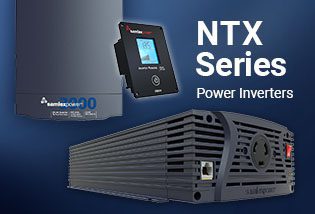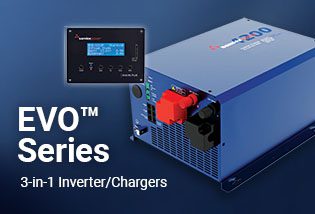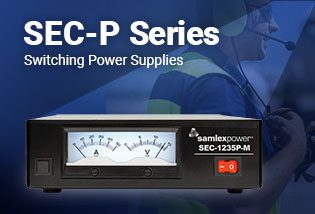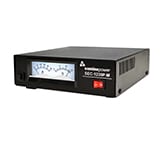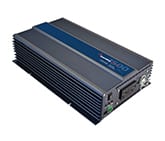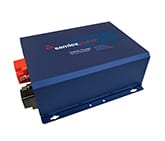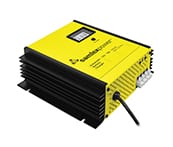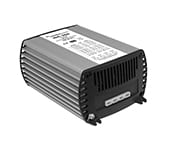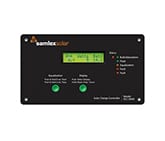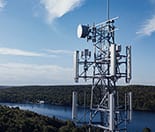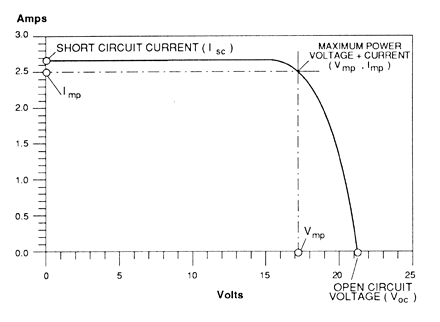Off-Grid Solar Power Basics
What is Photo Voltaic (PV)?
The word photo-voltaic is derived from two different words; the word photos, from the Greek, meaning light and the word ‘voltaic’ developed from the name of the Italian scientist, Volta, who studied electricity. This explains what a PV system does: it converts light energy from the sun into electrical energy.
What is in a photovoltaic (PV) system?
Non Grid-tied PV / Solar System
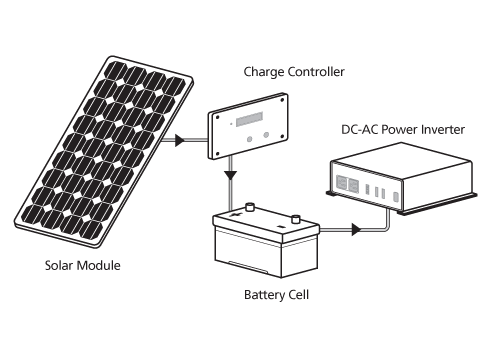
Above diagram shows a typical non-grid tied Photovoltaic (PV) System with its main components. It consists of a PV / Solar Panel (Module), Charge Controller, Batteries and Power Inverter. The PV / Solar Panel (Module) converts the solar light energy into DC electrical energy. The Charge Controller conditions the DC electrical voltage and current produced by the PV / Solar Panel (Module) to charge a battery. The battery stores the DC electrical energy so that it can be used when there is no solar energy available (night time, cloudy days etc). DC loads can be powered directly from the PV / Solar Panel (Module) / Battery. The inverter converts the DC power produced by the PV / Solar Panel (Module) / stored in the battery into AC power to enable powering of AC loads.
Grid-tied PV / Solar System
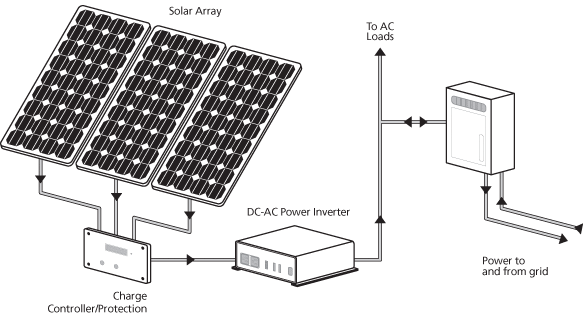
Above diagram shows a Grid-tied PV / Solar System. In this system, the Solar Panels (Modules) / Arrays directly feed to an inverter and the inverter is connected to an Electricity Transmission and Distribution System (referred to as the Electricity Grid) such that the system can draw on the Grid’s reserve capacity in times of need, and feed electricity back into the Grid during times of excess production. In order to safely transmit electricity to your loads and to comply with your power provider’s grid-connection requirements, you may need the following additional items:
- Power conditioning equipment
- Safety equipment
- Meters and instrumentation
What are solar (PV) cell modules and arrays?
The basic element of a PV System is the photovoltaic (PV) cell, also called a Solar Cell. An example of a PV / Solar Cell made of Mono-crystalline Silicon is shown below. This single PV / Solar Cell is like a square but with its four corners missing (it is made this way!).
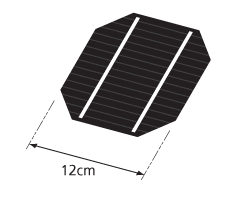
Theory Behind Operation of a PV/Solar Cell
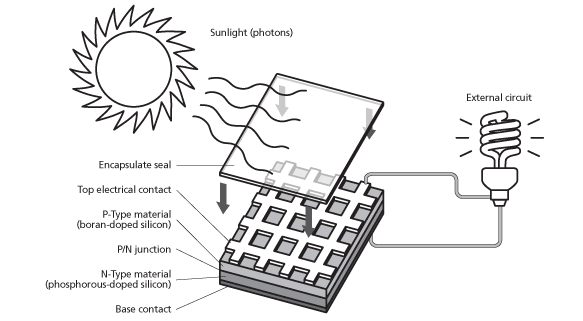
A PV / Solar Cell is a semiconductor device that can convert solar energy into DC electricity through the Photovoltaic Effect -conversion of solar light energy into electrical energy. When light shines on a PV / Solar Cell, it may be reflected, absorbed, or passes right through. But only the absorbed light generates electricity.
PV Module / Panel and PV Array
To increase their utility, a number of individual PV cells are interconnected together in a sealed, weatherproof package called a Panel (Module). For example, a 12 V Panel (Module) will have 36 cells connected in series and a 24 V Panel (Module) will have 72 PV Cells connected in series
To achieve the desired voltage and current, Modules are wired in series and parallel into what is called a PV Array. The flexibility of the modular PV system allows designers to create solar power systems that can meet a wide variety of electrical needs. Below is a schematic of a PV cell, Panel (Module) and Array.
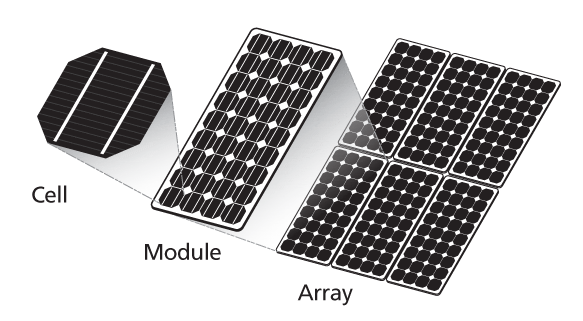
The cells are very thin and fragile so they are sandwiched between a transparent front sheet, usually glass, and a backing sheet, usually glass or a type of tough plastic. This protects them from breakage and from the weather. An aluminum frame is fitted around the module to enable easy fixing to a support structure. The picture below shows a small part of a Module with cells in it. It has a glass front, a backing plate and a frame around it.
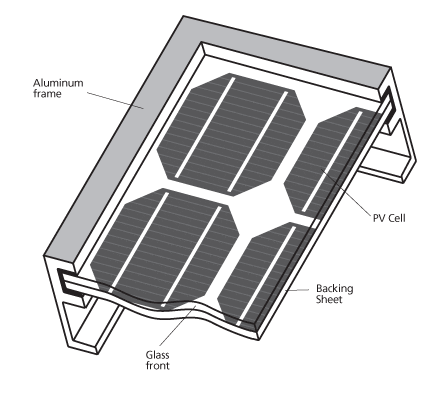
Bypass Diodes
As mentioned, PV / Solar cells are wired in series and in parallel to form a PV / Solar Panel (Module). The number of series cells indicates the voltage of the Panel (Module), whereas the number of parallel cells indicates the current. If many cells are connected in series, shading of individual cells can lead to the destruction of the shaded cell or of the lamination material, so the Panel (Module) may blister and burst. To avoid such an operational condition, Bypass Diodes are connected anti-parallel to the solar cells as in the diagram below. As a consequence, larger voltage differences cannot arise in the reverse-current direction of the solar cells. In practice, it is sufficient to connect one bypass diode for every 15-20 cells. Bypass diodes also allow current to flow through the PV module when it is partially shaded, even if at a reduced voltage and power. Bypass diodes do not cause any losses, because under normal operation, current does not flow through them.
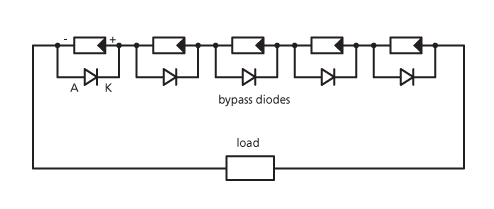
What are Current, Voltage and Power Curves of a Solar (PV) Panel?
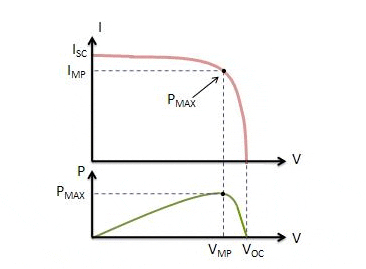
A Current (I) versus Voltage (V) Curve of a PV / Solar Module shows the possible combinations of its current and voltage outputs. A typical I-V curve for a 12 V Module is shown above.
The power in a DC electrical circuit is the product of the voltage and the current. Mathematically,
Power (P) in Watts (W) = The Current (I) in Amperes (A) X the Voltage (V) in Volts (V) i.e. W = V X A
A Solar (PV) Cell or a Panel / Module produces its maximum current when there is no resistance in the circuit, i.e. when there is a short circuit between its Positive and Negative terminals. This maximum current is known as the Short Circuit Current and is abbreviated as Isc. When the Cell / Panel (Module) is shorted, the voltage in the circuit is zero.
Conversely, the maximum voltage occurs when there is a break in the circuit. This is called the Open Circuit Voltage (Voc). Under this condition, the resistance is infinitely high and there is no current, since the circuit is incomplete. Typical value of the open-circuit voltage is located about 0.5 -0.6 V for Crystalline Cells and 0.6 -0.9 V for Amorphous Cells. These two extremes in load resistance, and the whole range of conditions in between them, are depicted on the I-V Curve. Current, expressed in Amps, is on the vertical Y-axis. Voltage, in Volts, is on the horizontal X-axis.
Maximum Power Point and Rated Power of Solar (PV) Panel
There is a point on the knee of the I-V Curve where the maximum power output is located and this point is called the Maximum Power Point (MPP). The voltage and current at this Maximum Power Point are designated as Vmp and Imp.
The values of Vmp and Imp can be estimated from Voc and Isc as follows: Vmp = (0.75 to 0.9) Voc Imp = (0.85 to 0.95) Isc.
The rated power of the PV / Solar Module in Watts (Pmax) is derived from the above values of voltage Vmp and current Imp at this Maximum Power Point (MPP):
Rated power in Watts, Pmax = Vmp x Imp
Example of I-V Curve and Ratings of a 12 V Solar (PV) Panel
This Maximum Power Point in the example curve given above is where Vmp is 17 Volts, and the current Imp is 2.5 amps. Therefore, the rated or the maximum power Wmax in watts is 17 Volts times 2.5 Amps, or 42.5 Watts.
Standard Test Conditions (STC) for Specifying PV / Solar Modules
The I-V curve is also used to compare the performance of PV / Solar Modules. The curve is, therefore generated based on the performance under Standard Test Conditions (STC) of sunlight and device temperature of 25°C. It assumes there is no shading on the device. Standard sunlight conditions on a clear day are assumed to be 1,000 Watts of solar energy per square meter (1000 W/m2 or 1 kW/m2). This is sometimes called one sun, or a peak sun. Less than one sun will reduce the current output of the PV device by a proportional amount. For example, if only one-half sun (500 W/m2) is available, the amount of output current is roughly cut in half.
What are types of batteries for solar systems?
There are several different types of battery chemistry including liquid lead-acid, nickel-iron (NiFe), nickel-cadmium (NiCad), alkaline, and gel-cell. Batteries are either sealed or vented. Simply, there are only two principal types of batteries: starting and deep-cycle.
Starting Batteries
Starting batteries are designed for high cranking power, but not for deep cycling. Used as energy storage, they will not last long in a deep cycle application. Starting batteries use lots of thin plates to maximize the surface area of the battery. This allows very high starting current but lets the plates warp when the battery is cycled. This type of battery is not recommended for the storage of energy in hybrid system. However, they are recommended as starting battery for the back-up generator.
Deep Cycle Batteries
Deep cycle batteries are the type of battery best suited for use with inverters. The physical dimension of the plates is thicker and the active material that holds the charge is denser to increase cycle life. The deep cycle type of battery is designed to have the majority of their capacity used before being recharged. They are available in many sizes and in either non-sealed or sealed types.
Usual battery inverters are optimized for use with lead acid batteries that have a nominal voltage of 2.0 volts per cell. NiCad/NiFe batteries (also called alkaline batteries) have a nominal cell voltage of 1.2 volts per cell. The nominal voltage of a NiCad / NiFe battery bank can be made the same as a lead acid bank just by juggling the number of cells (10 cells for 12 volts, 20 cells for 24 volts and 40 cells for 48 volt systems). However, the NiCad/NiFe battery bank must be charged to a higher voltage to fully recharge and will drop to a lower voltage during discharging compared to a similarly sized lead acid type battery.
What are some requirements for solar batteries?
Typical requirements for the battery to be used in long term storage are:
- low specific kWh-cost, i.e. the stored kWh during the whole life of the battery
- long lifetime
- high overall efficiency
- very low self-discharge
- low maintenance cost
- easy installation and operation
- high power
Specific kWh-cost
Usually it refers to a sum of investment and operation costs of the battery divided by the stored kWh (kWh) during its whole life. This cost is thus influenced by the battery’s lifetime.
Lifetime
The lifetime of the battery should be long, especially in order to keep the specific kWh-cost and the installation cost low, particularly in remote areas.
Overall efficiency
nE = nI n nV
The battery will usually need more charge than was taken out to fill it back up to its starting point. Typical average efficiencies are 80 to 85 % for stand-alone PV systems.
The voltage efficiency is determined by the average discharge voltage (VD) and average charging voltage (VC). VC is lower than VD particularly by internal resistance of the battery.
nV = VD / VC
The overall efficiency should be as high as possible, to be able to pass the biggest proportion of the energy in the battery, which is generated by the PV generator.
Self-discharge
The battery discharges itself even without load connected. This effect is caused by secondary reactions at its electrodes and proceeds faster with higher temperature or in older batteries. Thermodynamic instability of the active materials and electrolytes as well as internal- and external short-circuits lead to capacity losses, which are defined as self-discharge. This loss should be small, particularly in respect of annual storage.
Maintenance cost
The maintenance, e.g. water refilling in case of lead-acid batteries, should be kept as low as possible.
Power
In special cases, a battery must be highly loadable for a short time, e.g. at the start of diesel generators or in case of momentary power extension of PV systems. There are many types of batteries potentially available for use in stand-alone PV systems. Useful data of available batteries given in Table 1 shows approximated values and are provided as a guideline.
Table 1. Comparison between selection criteria of available batteries
| Type | Cycle life until 80%, DOD | Efficiency | Temp. range, °C | |
| Lead Acid | 500 – 1500 | 80 | -15° – .+50°C | |
| NiCd | 1500 – 3000 | 71 | – 40° – +45°C | |
| NiFe | 3000 | 55 | 0 – +40°C |
Since many values are dependent on charge and discharge conditions, they have not been standardized for PV applications and for test purposes until now. Therefore, the comparison between batteries and selection of the most suitable one for each application are not easy. Due to particular operating conditions with PV applications in practical operation, the cycle life given by manufacturer (and in Table 1) for cycling load can be reduced more than half.
According to Table 1 above, it follows that in most cases the lead-acid batteries would be the best choices for PV applications. The selection of suitable choices should be based on specific application.
What are characteristics of lead acid batteries?
A basic equivalent circuit of the lead-acid battery is modeled by a voltage source with an equilibrium voltage (VE) in series with an internal resistor (Rin)(see below). It must be noted here that this configuration can describe only a current state because the magnitude of VE and Rin are not actually constant, but is function of many parameters such as state of charge (SOC), temperature, current density, and aging of the battery.
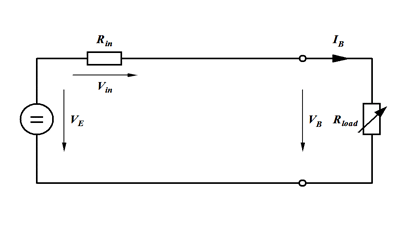
Furthermore, it is to consider that these parameters depend also on the current direction (charging or discharge). When the battery were at rest or under open-circuit condition VB = VE. When current is drawn from the battery, the voltage will be lower than VE. When current is flowing into the battery, the terminal voltage will be higher than VE.
Higher discharge current results in reduction of the terminal voltage. Therefore, to specify the state of the battery by the battery voltage, discharge current should be also measured.
In case of discharge, the minimum voltage level acceptable for a lead-acid battery is defined as discharge voltage threshold. Falling below this threshold is called deep discharge, with which the battery may suffer damage. In case that the battery is left longer after deep discharge, lead of the support structure is converted to lead-sulphate in rough-crystalline form, which during charging can be only bad or cannot be converted again anymore. As a result, the battery loses a part of its storage capacity; besides loss of support structure arises as well.
In practice, harmful deep discharge is to be prevented: the loads will be compulsory disconnected from battery as soon as the discharge voltage threshold is reached i.e. with the help of a so-called deep discharge protection (DDP). This threshold is basically given in the data sheets by the manufacturer for different discharge currents. Preferably, the value of this threshold should depend on the discharge current. The relation between the discharge current and the voltage during discharge for the lead-acid battery is presented below.
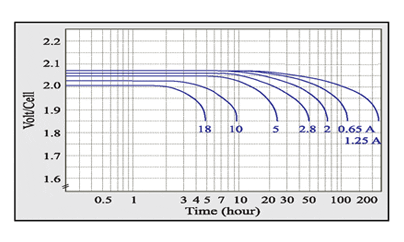
The above graph shows the discharge profile of a typical battery type at several constant current rates. The typical end-of-discharge voltage at these discharge rates can also be noticed where the voltage starts to drop steeply. Moreover, the end-of-discharge voltage varies between 1.75-1.9 V, depending on the battery type and the discharge current. Higher service capacity is obtained at the lower discharge rates. At higher discharge rates, the electrolyte in the pore structure of the plate becomes depleted, and it cannot diffuse rapidly enough to maintain the cell voltage. However, intermittent discharge, which allows time for electrolyte diffusion will improve the performance under high discharge rates.
Gassing
With 2.3 V and 2.4 V, gas is developed at the electrodes in the battery, by which the water is decomposed into hydrogen and oxygen. Both gases mix together in the battery providing detonating gas (explosive!) and escape through ventilation opening in the vent plug. With the gassing, the battery loses also water, which must be refilled according to maintenance within regular intervals. The gas is the unwelcome secondary reaction of the chemical conversion during charging because current is consumed for the electrolysis and therefore the storage efficiency of the battery is made worse unnecessarily. After the gassing voltage is exceeded, voltage stays approximately constant. The whole charging current during this period results in H2 and O2, which is defined as loss.
Freezing of electrolyte
For applications with low ambient temperature, the lead-acid battery must also be protected against freezing of electrolyte. The risk of freezing depends on the state of charge.
The graph below illustrates the freezing limit as a function of the state of charge.
Cycle life of lead acid batteries
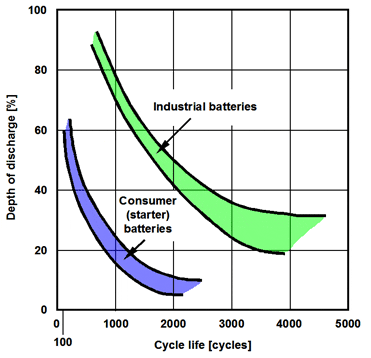
How a RV solar system works?
Download a schematic of how a RV solar system works with Samlex products and your RV.


